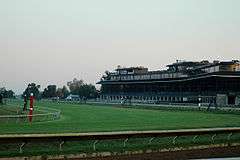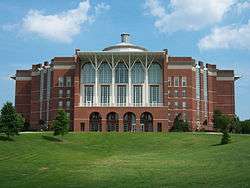Waveland State Historic Site
|
Waveland | |
 | |
  | |
| Nearest city | Lexington, Kentucky |
|---|---|
| Coordinates | 37°58′17″N 84°32′14″W / 37.97139°N 84.53722°WCoordinates: 37°58′17″N 84°32′14″W / 37.97139°N 84.53722°W |
| Built | 1845 |
| Architectural style | Greek Revival |
| NRHP Reference # | 71000342[1] |
| Added to NRHP | August 12, 1971 |
Waveland State Historic Site, also known as the Joseph Bryan House, in Lexington, Kentucky is the site of a Greek Revival home and plantation now maintained and operated as part of the Kentucky state park system. It was the home of the Joseph Bryan family, who followed Daniel Boone through the Cumberland Gap, and became an early settler and horseman of this region.
History
The history of Waveland begins with the Boone and Bryan families. The two families met in the Yadkin River Valley, North Carolina,when the Boones moved onto the land next to the Bryan family. It was said that the Bryans outfitted several of the Boones hunting trips. Eventually William Bryan married Daniel Boone's sister, Mary Boone. William and Mary had a son, Daniel Boone Bryan.[2] Daniel Boone surveyed the land that he would give to his nephew, Daniel Boone Bryan, who was a renowned historian, frontiersman, and poet. The area surveyed was about 2,000 acres (810 ha) about six miles from present-day downtown Lexington, Kentucky.
Daniel Boone Bryan
Daniel Boone Bryan settled the land around Waveland by 1786. The name Waveland came from the waves that were visible when the wind blew the fields of grain and hemp surrounding the house. The area was once the home of the biggest hemp and rope producers of the nation. When Daniel Boone Bryan moved to what is now Waveland, he built a small stone cabin. The Waveland mansion was constructed between the fall of 1844 and late 1848. Joseph Bryan had the house built "to please his father" according to a letter written by his son Elijah in 1845. Bryan constructed his office with seven doors, each for a different part of his life. There was a door that connected to the formal dining room, where he and guests would eat. Another door, which locked from his office, was to two upstairs rooms where he would allow travelers to stay if they paid him. He made sure he was able to lock them in for safety reasons. The travelers could not leave their room unless Joseph unlocked the door, meaning he was safe from being robbed or attacked by them at night. Another door led to the fields where the slaves worked. This meant easier communication with them when necessary. Another door led out to the road where businessmen would often travel in to see him. Being an important and successful businessman in Kentucky, he often was visited by others. One door lead into the family parlor, where he could be with his children. The remaining two doors were closets, which were used as safes.[3]
Bryan was at once a gunsmith, having a large shop and employing twenty five men at one time; manufacturer of saltpeter and gunpowder; operator of a gristmill, a blacksmith shop, Baptist church, a female seminary, a distillery and a paper mill.[4] He was able to manage all of these successfully. He and his wife Elizabeth had twelve children.
Joseph Bryan
Bryan's son, Joseph, inherited Waveland and made the most memorable piece of this historic site. Joseph Bryan's wife convinced him to construct a more memorable and beautiful home than his father had built. He tore down the old stone cabin two years after his father's death so that he could build the large, opulent house that his wife wanted. To reduce construction costs, Bryan constructed the stairway rail using flat pieces of wood instead of rounded ones. Although his wife wanted expensive marble baseboards, Bryan used cheaper stones and had them painted to look like marble.[5]
Proof of how successful the Bryans' businesses were was that he was able to construct most of the house using only his businesses and materials on his land; the lumber he used came from Waveland plantations, the wrought iron was made at the Waveland blacksmith, the bricks used in the buildings were made from some clay gathered on the land, which was then burned on site. The resources that were not at Waveland were the stones that were used for the foundation of the house and also for some decorative work. The stones that were needed were quarried and dressed at Tyrone on the Kentucky River and moved to Waveland.[6]
Bryan decided to build a classic Greek Revival structure. Inspired by the work of Lexington architect John McMurtry, Bryan hired Washington Allen, a well-known Lexington contractor, to oversee the construction of his new home.[7] The house contained fourteen high ceiling rooms, which made them each cooler in the summer, as heat rises. The main doorway of the mansion is considered to be an exact replica of the doorway of the north entrance to the Erechtheion at the Acropolis in Athens. The house also contains a porch on either side, to give a view of the beautiful surrounding country side, as well as a spacious hall and a portico.
Throughout their time at Waveland, the Bryans kept slaves. There were thirteen slaves, three women and ten men. The women were to keep the house clean as well as do the cooking. Margaret Cartmell Bryan, Joseph's wife, made all of the clothing for all of the slaves and the Bryan family. The invention of the sewing machine significantly reduced the time it took her to make clothing.[3]
The male slaves were in charge of the farm. Each one had to keep 20 acres (8.1 ha) of land. In order to save time traveling, the Bryans allowed the slaves to build houses on the property they kept. The slaves at Waveland enjoyed freedoms that were uncommon for other slaves of the day. When they were not working, they were allowed to hunt for themselves. They were also allowed to buy and sell at the local markets, keeping any profits for themselves. Joseph Bryan also allowed the slaves to keep weapons. The slave quarters were two bricks thick, making them better insulated than many other homes in Kentucky.[3]
Joseph Bryan supported the Confederacy during the Civil War and gave them supplies such as horses and food produced on his land. When Union authorities discovered this, they sought to arrest him. Bryan fled to Canada, returning years later when the war had ended.[3] As a result of the war, the slaves at Waveland were emancipated, but they chose to stay and continue working for Bryan, who paid them for their labor, but charged them rent.[3]
Joseph Henry Bryan
Joseph Henry Bryan, one of Bryan's eleven children, lost his house, so he and his wife and children moved back into Waveland with his father.[8] Eventually, Joseph Bryan, Sr. moved out, leaving Joseph Henry Bryan as the owner of Waveland. While he owned Waveland, he established it as one of the premier thoroughbred and trotter farms in Kentucky. Waveland produced some great horses such as "Waveland Chief", "Ben-Hur", "Eric", "Olaf" and "Wild Rake", who never lost a heat and was sold to William Rockefeller for $7800 in the 1880s. Joseph Henry Bryan also built a race track across from the mansion.[7] He and other businessmen would go out to watch horse races. The women, who were not allowed to go, would often go up to the top floor of the house and watch the races with their binoculars.[3]
Joseph Henry Bryan was a notorious gambler. In less than seven years, he lost over one million dollars. Another family member had to sell their home so that they could try to keep Joseph Henry Bryan from losing the property. Eventually, however, Bryan was unable to pay his debt. For this, he was never forgiven by his family. He had to sell the house at auction just to try to pay off the debt.[3] Salle A. Scott bought Waveland in 1894. She sold the property in 1899 to James A Hullet. In 1956, the Commonwealth of Kentucky bought the house and less than 200 acres (81 ha) of the original 2,000 acres (810 ha) for use by the University of Kentucky as experimental farmland.
Museum
In 1957, Waveland became a museum that depicted Kentucky life from pioneer days to the Civil War. The house sits on 10 acres of land and now depicts life on a plantation during the 1840s. Period-appropriate furniture was donated to the site. Many of the buildings did not survive, but Waveland currently contains the mansion, decorated in Antebellum style, and four outbuildings, which are the ice house, a two-story brick building that was the slave quarters, a barn, and a smokehouse.
Tours are given daily for much of the year, and the tour guides dress in the style of the 1840s. Tours include the historic house, the slave quarters, smokehouse and ice house, and focus on the Bryan family and life on a 19th-century Kentucky plantation.
Notes
References
- "Historic Homes and Historic Sites in Lexington, KY". Horse Capital of the World: Lexington, Kentucky Convention and Visitors Bureau. 07 Nov. 2011.
- "History – Waveland – Historic Sites – Kentucky State Parks". Park News – Kentucky State Parks. 06 Nov. 2011.
- Kleber, John E. "Waveland." The Kentucky Encyclopedia. Lexington, KY: University of Kentucky, 1992. Print.
- Tapp, Hambleton. Waveland Home of the Bryans. Lexington, KY: S.n., 1956. Print.
- "Waveland-Lexington Kentucky – National Register of Historic Places Travel Itinerary". U.S. National Park Service – Experience Your America. 06 Nov. 2011.
- Young-Brown, Fiona. "Waveland State Historic Site, Lexington, KY".
- Christen, Waveland tour guide. Interviewed on November 12, 2011
- "Bryan Family". Jarvis Family and Other Relatives. 26 Nov. 2011.


